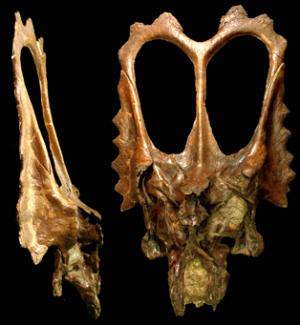Science News
Mojoceratops
July 9, 2010

What do you get when you try and name a flamboyant dinosaur over a few beers? Mojoceratops! This plant eater about the size of a hippopotamus appeared about 75 million years ago during the Late Cretaceous—10 million years earlier than its well-known cousin, the Triceratops.
“I tried to come up with serious names after that, but Mojoceratops just sort of stuck,” said Nicholas Longrich, a postdoctoral associate at Yale University. With the publication of Longrich’s paper describing his find in the Journal of Paleontology, the name is now official.
But, with the dinosaur’s frilly, heart-shaped skull, Longrich found that the name actually fits. “I discovered that ‘mojo’ is an early 20th-century African-American term meaning a magic charm or talisman, often used to attract members of the opposite sex,” he said. “This dinosaur probably used its frill to attract mates, so the name made sense.” (You can find a great artist’s rendering of Mojoceratops on Discover’s Discoblog.)
Longrich didn’t make his discovery in the field, digging for bones, but rather in museums, sorting through them. While studying dinosaur fossils at the American Museum of Natural History in 2008, he found the distinctive skull in the Chasmosaurus collection. It didn’t quite fit. Trips to other museums in Western Canada turned up more examples that didn’t fit with the rest of the known species.
All in all, Longrich turned up eight partial skulls of the new species, which now boasts a name with just as much flair as its unusually shaped head.
“You’re supposed to use Latin and Greek names, but this just seemed more fun,” Longrich said. “You can do good science and still have some fun, too. So why not?”
Photo by Nicholas Longrich